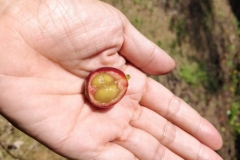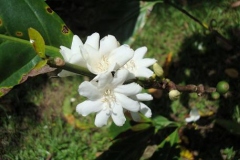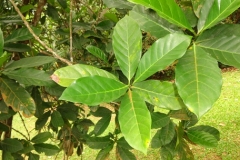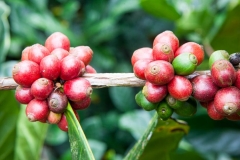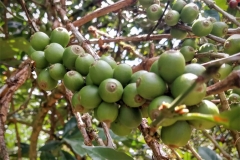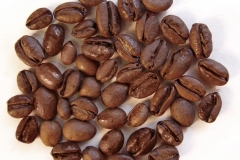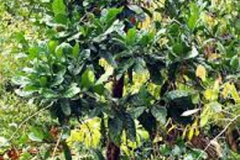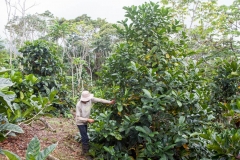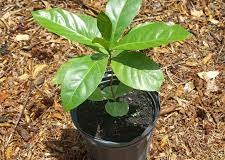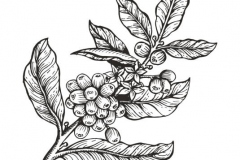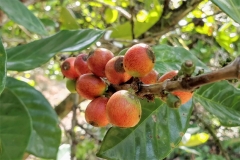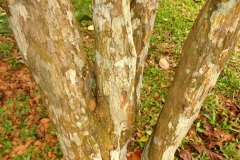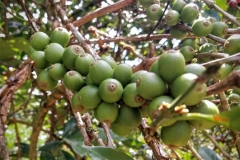| Liberian coffee Quick Facts | |
|---|---|
| Name: | Liberian coffee |
| Scientific Name: | Coffea liberica |
| Origin | Tropical West and Central Africa |
| Colors | Initially green and progressing to yellow, orange, or red as they mature |
| Shapes | Small, rounded, about 18-30 mm long |
| Flesh colors | Usually sweet and has a juicy texture |
| Taste | Earthy, robust rich taste and sometimes smoky notes |
| Health benefits | Enhanced cognitive function, Boost metabolism, Improved liver health, Improved physical performance, Heart Health, Diabetes Prevention, Weight Management, Reduced Risk of Diseases, Energy Boost and Mental Alertness, Liver Protection |
| Name | Liberian coffee |
|---|---|
| Scientific Name | Coffea liberica |
| Native | Tropical West and Central Africa. Nowadays, it is fairly widely cultivated especially in Guyana, Surinam, Bioko (Fernando Po), Sao Tomé, Liberia, Malaysia and the Philippines, and to a lesser extent also in Sierra Leone, Ivory Coast, Nigeria, Congo (Brazzaville), Mauritius, Sri Lanka, India, Thailand, Vietnam, Taiwan and on Timor |
| Common Names | Coffea liberica, Liberian coffee, Liberian robusta, Liberian cherry coffee, Liberian coffee bean, Liberian coffee tree, Liberian coffee plant, Liberian coffee shrub, Liberian coffee bush, Coffea liberica var. liberica, Liberica coffee, Liberian giant coffee, Liberian elephant bean, Liberian lowland coffee, Liberian forest coffee, Liberian mountain coffee, African coffee, West African coffee, Nigerian coffee, Liberian Bourbon, Cavalla coffee, Bong coffee, Grand Bassa coffee, Liberian Mocha, Monrovian coffee, Liberian Peaberry coffee, Nigerian coffee |
| Name in Other Languages | Afrikaans: Liberiese Koffie Albanian: Kafeja Liberiane Amharic: Liberyan Bunna (ሊበሪየን ቡና) Arabic: Qahwat Liberiyā (قهوة ليبيريا) Armenian: Liberiakan Surj (Լիբերիական Սուրճ) Azerbaijani: Liberian Qəhvəsi Basque: Liberiar Kafea Belarusian: Liberyyskaya kava (Ліберыйская кава) Bengali: Laibēriẏāna kōphi (লাইবেরিয়ান কফি) Bosnian: Liberijanska Kafa Bulgarian: Liberiyska Kafe (Либерийска Кафе), liberiĭsko kafe (либерийско кафе) Burmese: Lo bhee reeyarr kawhpe (လိုဘီးရီးယားကော်ဖီ) Catalan: Cafè Liberià Cebuano: Liberianong Kape Chichewa: Kafu ya Liberian Chinese: Lìbǐlǐyà kāfēi (利比里亚咖啡), Da guo ka fei, Da ka fei shu, Da li ka fei (大粒咖啡) Corsican: Caffè Liberianu Croatian: Liberijanska Kava Czech: Liberijská Káva, kávovník liberijský Danish: Liberiansk kaffe Dutch: Liberiaanse koffie, Liberiakoffie. English: Liberian coffee, Liberica coffee, Excelsa coffee Esperanto: Liberiana Kafeo Estonian: Libeeria Kohv Filipino: Kape ng Liberia Finnish: Liberian kahvi French: Café libérien, Café du Libéria, Caféier du Liberia, Café libérica Frisian: Liberiërske Kofje Galician: Café Liberiano Georgian: Liberiuli q’ava (ლიბერიული ყავა) German: Liberianischer Kaffee, Liberiakaffee, Liberiakaffeebaum, Liberiakaffeestrauch Greek: Liverikós kafés (Λιβερικός καφές) Gujarati: Lā’ibēriyan Kŏphī (લાઇબેરિયન કૉફી) Haitian Creole: Kafe Liberian Hausa: Kofi na Liberia Hawaiian: Kope Liberian Hebrew: Kafe Libri (קפה ליברי), Kafe Liberay (קפה ליברי) Hindi: Lāibēriyan kofī (लाइबेरियन कॉफ़ी) Hmong: Liberian Cov Khoom Hungarian: Libériai Kávé Icelandic: Líberískt Kaffi Igbo: Kọfi Liberia Indonesian: Kopi Liberia, Kopi Liberika Irish: Caife Libéiríoch Italian: Caffè liberiano, Caffe liberica Japanese: Riberian kōhī (リベリアンコーヒー), Riberikakōhīnoki (リベリカコーヒーノキ) Javanese: Kopi Liberia Kannada: Laibīriyan kapha (ಲೈಬೀರಿಯನ್ ಕಾಫಿ) Kazakh: Liberïyalıq Kofe (Либериялық Кофе) Khmer: Kafe Liebirean (កាហ្វេលីរីយ៉ាន់) Korean: Libeolia keopi (리베리아 커피) Kurdish: Qahwa Liberian Kyrgyz: Liberïyalık Kofe (Либериялык Кофе) Lao: Kā Fē Lī Bēn (ກາເຟລິນີລິເອນ) Latin: Liberiana Coffea Latvian: Libērijas Kafija Lithuanian: Liberijos Kava, Liberijos kavamedis Luxembourgish: Liberianesch Kaffi Macedonian: Liberisko Kafe (Либериско Кафе) Malagasy: Kafe Liberiana Malay: Kopi Liberia Malayalam: Laibīriyaṇ kōphi (ലൈബീരിയൻ കോഫി), kofi liberika (കോഫി ലിബെറിക) Maltese: Kafè Liberjan Maori: Kawhe Riberiana, kaope papa‘ā Marathi: Lā’yabēriyan kŏphī (लायबेरियन कॉफी) Mongolian: Liberiin Kofe (Либерийн Кофе) Myanmar (Burmese): Lohbēriyāku: Phi (လိုဘီးရီးယားကော်ဖီ) Nepali: Laibēriyan Kaphī (लाइबेरियन कफी) Norwegian: Liberiansk kaffe Pashto: Lāībarīayī Qahwah (لایبریايی قهوه) Persian: Qahve Liberia (قهوه لیبریا), Ghahveh Liberīā (قهوه لیبریا) Pohnpeian: Marasau, wahnrose pwetepwet Polish: Kawa Liberyjska Portuguese: Café liberiano, Cafeeiro-da-libéria, Café-libérica, cafeeiro-excelsa Punjabi: ਲਾਈਬੀਰੀਆਈ ਕੌਫੀ (Lā’ībīrī’ā’ī Kau’phī) Romanian: Cafea Liberiană Russian: Liberiyskiy kofe (Либерийский кофе), Kofe liberica (Кофе либерика) Samoan: Kofi Liberian Scots Gaelic: Caife Libèireach Serbian: Liberijanska Kafa (Либеријанска Кафа) Sesotho: Kofi ea Liberia Shona: Kofi reLiberia Sindhi: Lā’ibīryā’īna Qahwah (لائبيريائين قهوه) Sinhala: Layībīriyānu Kābyā (ලයිබීරියානු කාබ්යා) Slovak: Libérijská Káva Slovenian: Liberijanska Kava Somali: Qaxwaaca Liberiya Spanish: Café liberiano, Cafeto de Liberia Sundanese: Kopi Liberia Swahili: Kahawa ya Liberia Swedish: Liberianskt kaffe Tajik: Kafeyi Liberiyā (Кафеи Либерия) Tamil: Laipīriya kāpi (லைபீரிய காபி) Telugu: Libīriyan kāphī (లిబీరియన్ కాఫీ) Thai: Kaafae Liberian (กาแฟลิเบรียน), Kafae bai yai (กาแฟใบใหญ่) Turkish: Liberya kahvesi Turkmen: Liberýa çagaly Ukrainian: Liberiysʹka Kava (Ліберійська Кава), Liberika (Ліберіка) Urdu: Lāibērīn kāfī (لائبیرین کافی) Uzbek: Liberiyalik Kahva, Liberiya qahvasi Vietnamese: Cà phê Liberia, Càphê Libéri, Cà phê mít Welsh: Coffi Liberiaidd Xhosa: Ikhofi yeLiberia Yiddish: Liberyan Kofe (ליבעריאַן קאַפֿע) Yoruba: Oti Liberia Zulu: Ikhofi leLiberia |
| Plant Growth Habit | Large evergreen, robust shrub or tree |
| Growing Climates | Lowland to lower montane rain forest, gallery forest, forest margins and even in open scrub vegetation |
| Soil | Prefers well-drained soils with good fertility. It can tolerate various soil types, including loamy, sandy loam, and clay loam soils. The soil should have good water-holding capacity while allowing excess water to drain effectively |
| Plant Size | 20 to 40 feet (6 to 12 meters) and have a spread of around 15 to 25 feet (4.5 to 7.5 meters) |
| Root | Taproot is usually thick and robust, serving as the main anchor for the plant. It grows directly downwards and provides stability and support to the coffee plant |
| Stem | Plants have a central main stem that grows upright from the ground. From the main stem, lateral branches emerge that extend horizontally and vertically, forming the framework of the coffee plant’s canopy |
| Bark | Bark is usually brown or gray and has a slightly rough or ridged texture that protects the inner tissues of the stem and provides structural support |
| Leaf | Leaves are elongated and oblong in shape. They have a pointed tip and a smooth or slightly serrated edge. Leaf shape helps maximize the surface area available for photosynthesis, allowing the plant to capture sunlight efficiently |
| Flowering season |
|
| Flower | Small, white, and fragrant, about 30-40 mm diam. They are typically star-shaped and consist of five petals that spread outward, exposing the reproductive parts of the flower. Calyx lobes small and inconspicuous. Corolla tube about 10-12 mm long |
| Fruit Shape & Size | Small, rounded, about 18-30 mm long and typically about the size of a grape |
| Fruit Color | Initially green and progressing to yellow, orange, or red as they mature |
| Flesh | Usually sweet and has a juicy texture |
| Seed | Seed (commonly referred to as “bean”) 0.7-1.5 cm long, grey-brown-green, with a groove on the inner surface; testa thin, silvery |
| Flavor/Aroma | Earthy and wine-like aromas with nutty or spicy undertones |
| Taste | Earthy, robust rich taste and sometimes smoky notes |
| Plant Parts Used | Seeds, leaves, bark, fruit pulp, Infusions and Extracts |
| Propagation | By seeds, stem cutting, Grafting and Tissue Culture |
| Lifespan | Approximately 20 to 30 years. However, under optimal conditions and with proper care, some plants may live even longer, reaching up to 40 years or more |
| Varieties |
|
| Major Nutrition |
|
| Health benefits |
|
Plant Description
Liberian coffee trees are usually medium to big, evergreen shrubs or trees with a round canopy. They can grow to be 20 to 40 feet tall (6 to 12 meters) and 15 to 25 feet wide (4.5 to 7.5 meters) across. The branches spread out horizontally from the trunk, making the tree look wide and thick. The plant grows in lowland to lower Montana rain forest, gallery forest, forest edges, and even in open scrub vegetation. It grows best in rich soils that drain well. It can grow in different kinds of dirt, like loamy, sandy loam, and clay loam. The soil should be able to hold water well while letting extra water drain away well. Most of the time, it is grown in tropical areas with mild weather and a lot of rain. It grows well at altitudes between 2,000 and 4,000 feet above sea level, which is between 600 and 1,200 meters. Liberian coffee is picked when it is ripe and then processed to get the coffee beans. The coffee beans are then roasted and made to make a fragrant and tasty drink.
Appropriate growing environments for Liberian coffee
Liberian coffee thrives in specific growing environments that provide the necessary conditions for its optimal growth and development. Here are the appropriate growing environments for Liberian coffee:
- Climate: Liberian coffee grows best in a tropical setting with mild temperatures and a lot of rain. Ideal temperatures for its growth are between 20°C (68°F) and 30°C (86°F). It is important to avoid big changes in temperature and frost because they can hurt the plant.
- Altitude: Most Liberian coffee is grown at higher elevations, between 600 meters (2,000 feet) and 1,200 meters (4,000 feet) above sea level. Higher levels have cooler temperatures, which slow the beans’ growth and help them develop their flavors more slowly.
- Rainfall: Liberian coffee can’t grow without enough rain. It grows well in places where it rains from 1,500 to 2,500 millimeters (60 to 100 inches) per year. But it’s important to make sure there’s enough drainage so the plant doesn’t get too much water, which can hurt its health.
- Soil: Liberian coffee grows best in soils that are rich and have good drainage. It can grow in many different kinds of soil, such as loamy, sandy loam, and clay loam. But the earth should be able to hold a lot of water while letting the extra water drain well.
- Shade: Liberian coffee grows best in places with some shade or sun that has been filtered. It is often grown under the shade of taller trees or other buildings that block the sun. The shade helps keep the temperature even, keeps the leaves from getting sunburned, and makes an environment that is good for growing coffee.
- Wind Protection: Strong winds can hurt coffee plants in Liberia, which can slow the growth of the beans. Planting windbreaks or putting up natural barriers like trees or hedges can keep the coffee plants from being damaged by strong gusts of wind and help them keep their shape.
Roots
The main root of Liberian coffee plants grows straight down into the soil. The taproot is generally thick and strong, and it acts as the plant’s main anchor. It shoots straight down and gives the coffee plant stability and support. From the taproot, a lot of horizontal roots spread out in all directions. These lateral roots spread out in the top layer of dirt. They help anchor the plant, take up water and nutrients, and keep the plant steady. The plants also make roots that grow from the stem or shoots above the ground. These are called adventitious roots. These roots can grow out of the bottom of the stem and into the dirt to give the plant more support and water absorption. The roots have tiny hairs on them that soak up water and nutrients from the dirt. These root hairs make the roots bigger, which makes it easier for the plant to take in water and nutrients.
Stem
Most Liberian coffee plants grow straight up, with the main stem and branches also going straight up. But the stem can also bend or branch, based on how it grows and how it is cared for. The plants have a main stem that grows straight up from the ground in the middle. The main stem of the plant gets woody as it grows. It is the main support for the coffee plant’s stems, leaves, and parts that make coffee. From the main trunk, branches grow out in a way that looks like a whorl or like they are switching places. The framework of the coffee plant’s top is made up of these horizontal and vertical branches. The way the plant grows branches lets the leaves spread out and makes it easier for the plant to get sunlight.
The bark on the stem is rough and gets more noticeable as the plant gets older. Most of the time, the bark is brown or grey and has a rough or ridged structure. The bark covers the stem’s inner tissues and gives the stem its shape.
Bark
The bark is rough and scaly. As the plant gets older, the bark stands out more and gets a little bit rough or ridged. The bark has ridges and furrows that make a unique pattern and make the stem look nice. The bark’s color changes based on how old the stem is. The bark on younger stems is generally smoother and lighter in color, with shades of light brown or grey. As the stem gets older, the bark gets darker and grayer or browner.
The bark is pretty thick, which protects the stem cells underneath it. The bark gets thicker as the stem gets older, which makes it stronger and more durable as a whole. The bark is very important because it keeps the inner parts of the stem safe from damage, disease, and environmental stress. It works as a barrier, stopping pathogens, insects, and other harmful things from getting into the stem. This keeps the plant healthy.
Leaves
Liberian coffee has opposite leaf arrangement, which means that each pair of leaves along the stem is exactly opposite the other pair. This opposite arrangement gives the plant an attractive and balanced look. The shape of the leaves is long and narrow. They have a sharp tip and a smooth or slightly jagged edge. The shape of the leaf helps make the most of the area that can be used for photosynthesis. This makes it easier for the plant to take in sunshine.
The leaves are a dark green that is shiny and bright, which is typical of many coffee species. The dark green color of the leaves is an adaptation that helps them take in enough light for photosynthesis. The veins in the leaves are easy to see and run all the way through the leaf blade. These lines make up a network of vascular tissue that moves water, nutrients, and sugars between the different parts of the leaf and the rest of the plant.
The leaves can be different sizes, but they are usually big compared to other types of coffee. Coffea liberica is known for having leaves that are bigger than most plants. The large leaf surface gives more room for photosynthesis, which helps the plant make more energy generally. Petioles, which are thin stalks that connect the leaf blade to the stem, hold the leaves to the stem. The petioles let the leaves move and change position so that they get the most sunlight.
Flower
Inflorescences, which are groups of flowers, are called axillary racemes. The leaf axils, which are the points where the leaf meets the stem, are where these racemes grow. Each raceme has several flowers lined up along its center. They are small, white, and smell good. They are usually in the shape of a star and have five petals that spread outward to show the parts of the flower that make seeds. Most coffee plants in Liberia bloom and make flowers once a year, but the exact time can change based on the weather and how the plants are cared for. Most plants flower when it rains or when they sense something in their surroundings that tells them to.
The majority of Liberian coffee flowers are self-pollinating, which means they have ways to fertilize themselves. Cross-pollination can also happen when insects like bees and butterflies visit the flowers and move pollen from one flower to another. Pollinators are drawn to the flowers because they smell good. People often say that the smell is sweet and flowery, which draws insects to the flowers so they can help pollinate them.
The stamens, which are the male reproductive parts, are made up of a filament and an anther. The pollen, which includes the male gametes, is made by the anthers. The stigma, the style, and the ovary are all parts of the pistil, which is the female reproductive system. The stigma is the surface that gathers pollen, and the style is the thin tube that connects the stigma to the ovary. After fertilization, the ovules in the ovary turn into coffee beans.
Fruits
Most Liberian cherries are about the size of a grape and are small and round. They look like cherries, which is how they got the name “coffee cherry.” As the cherries ripen, their color changes. They start out green and turn yellow, orange, or red, based on the type of coffee and how ripe it is. Liberian coffee has many different parts. The thin, smooth layer on the outside is called the skin or peel. It keeps the inner layers from getting hurt. The soft middle layer, called the pulp or mesocarp, is under the skin. Most of the time, the meat is sweet and juicy. The inner layer, called the paper or endocarp, is wrapped up in the pulp. It is thin and has a texture like paper. It is wrapped around the coffee beans.
It takes several months to fully ripen, and the time it takes depends on the weather and how it was grown. When the cherries are at the right stage of ripeness, they are picked by hand or with machines. To get the best flavor and quality, cherries should be picked when they are fully ripe. The taste can be different, but it’s usually strong and bold. It is known for having a full, rich taste with notes of earth, fruit, and sometimes wine. The exact flavor profile can be affected by things like the type of coffee, how it was grown, and how it was processed after it was picked.
Seeds
Liberian coffee seeds, which are actually beans, are wrapped in a layer of paper inside the coffee cherry. Most Liberian coffee has two seeds, which are flat on one side and rounded on the other. Depending on the type of coffee and how it grows, the form and size of the seeds may be a little different.
The thin, protective skin on the outside of the seed is called the seed coat or testa. It is brown in color. It stops wetness from escaping and gives the embryo inside an extra layer of protection. The endosperm is the biggest part of the seed and makes up most of the coffee bean. The endosperm is full of carbs and gives the growing coffee plant energy and nutrients. Inside the endosperm is the embryo, which is where the coffee plant’s ability to grow is stored. The embryo is a small plant with a root (called a radicle), a shoot (called a plumule), and two leaves called cotyledons. The cotyledons are the immature leaves that feed the growing plant when it first sprouts.
History
Liberica coffee has a long and interesting past that goes all the way back to the 1800s. This rare coffee got its name from the place where it was grown and harvested for the first time, which was Liberia in West Africa. Liberica coffee quickly became famous among coffee lovers because of its unique flavor, which has floral, fruity, and smoky notes, and its large almond-shaped beans. In the late 1800s, most Arabica coffee farms around the world were destroyed by a disease called coffee rust. This is how the Philippines became involved with Liberica coffee.
In 1898, the American government sent Liberica coffee to the Philippines, a former colony, as a possible replacement crop in answer to the crisis. As the rust-resistant Libericas grew well in the soil of the Philippines, the country quickly became one of the top producers of the specialty coffee, helping to develop and spread its unique flavor. Even though Liberica coffee was popular at first, the business slowly died out as Arabica and Robusta beans became more popular. This made Liberica coffee almost impossible to find in the 20th century.
But Liberica coffee has been making a comeback lately, thanks to a renewed interest around the world in special and unique coffee flavors. Small, dedicated groups of farmers and coffee lovers, especially in the Philippines and Malaysia, have taken on the task of preserving and promoting the history and legacy of Liberica coffee. They are working to reestablish it in the specialty coffee market while honoring its unique roots. Liberica coffee beans are a popular choice for Filipino coffee drinkers today, and local Sari-Sari stores often have bags of newly roasted Barako coffee.
Varieties of Liberian coffee
Liberian coffee is primarily known for its cultivation of the Coffea liberica variety. However, within the Coffea liberica species, there are different cultivars or varieties that exhibit variations in flavor profiles, growth characteristics, and adaptability to specific regions. Here are some varieties of Liberian coffee:
- Liberica Barako: This type, which is also called “Barako” or “Kapeng Barako,” is from the Philippines. It has also been grown in Liberia. Liberica Barako is known for having big beans and a strong flavor. It makes strong, full-bodied coffee that tastes earthy, smoky, and sometimes nutty. People know that the Barako type is resistant to diseases and pests.
- Liberica Excelsa: Excelsa, which is also called “Coffea dewevrei,” is a type of Coffea liberica. It is known for having a unique flavor that makes it stand out from other types of coffee. The Excelsa beans are smaller than other kinds of Coffea liberica, but they have a taste all their own. Excelsa coffee has a taste that is fruity and sour, with hints of dark fruit, floral notes, and richness like that of wine.
- Liberica Java: Java liberica comes from Java, Indonesia, which is where its name comes from. It has also been grown in Liberia. This type is known for having beans that are big and have a balanced flavor. Java liberica has a rich earthiness, a little bit of acidity, and a little bit of sweetness. People often say that it has a nice, well-balanced taste.
- Liberica S-274: S-274 is a chosen cultivar of the Coffea liberica plant that has become famous because of its good qualities. It is known for having a high output potential, being resistant to disease, and making good coffee. The S-274 beans are big and make a strong, full-bodied cup of coffee most of the time. Deep, earthy notes and bits of chocolate are often used to describe the taste.
Health benefits of Liberian coffee
Liberian coffee, like many other types of coffee, offers several potential health benefits when consumed in moderation. Here is some of the health benefits associated with Liberian coffee:
1. Antioxidant properties
Coffee is full of antioxidants like chlorogenic acid and caffeine, which help protect the body from oxidative stress caused by dangerous free radicals. Antioxidants are known to lower the chance of chronic diseases like heart disease, certain cancers, and neurodegenerative disorders.
2. Enhanced cognitive function
Liberian coffee contains caffeine, which can stimulate the central nervous system and make you more aware, better able to focus, and smarter. It can also help you feel less tired and respond faster.
3. Boosted metabolism
Researchers have found that coffee briefly speeds up your metabolism, which could help you control your weight. The caffeine in Liberian coffee can help burn fat and improve physical performance, which is good for people who work out or do other physical tasks regularly.
4. Reduced risk of certain diseases
Several health problems are less likely to happen if you drink coffee in moderation. Studies have shown that drinking coffee regularly may lower the chance of type 2 diabetes, liver diseases (like liver cancer and cirrhosis), Parkinson’s disease, and some types of cancer, like colorectal and endometrial cancer.
5. Improved liver health
It has been found that coffee helps protect the liver. Regularly drinking Liberian coffee has been linked to a lower chance of liver diseases like non-alcoholic fatty liver disease (NAFLD), liver fibrosis, and liver cirrhosis. It may also make liver cancer less likely.
6. Mood enhancement and depression prevention
Caffeine in coffee is a mild stimulant that has been shown to improve mood, make people more aware, and lower the risk of depression. But it’s important to remember that too much coffee can have the opposite effect and make you feel anxious or antsy.
7. Improved physical performance
If you drink Liberian coffee before you work out or do other physical activities, it may increase your stamina, make your muscles stronger, and make you feel less tired. Caffeine in coffee causes adrenaline to be released, which can improve stamina and ability in sports as a whole.
8. Heart Health
Heart disease is less likely to happen if you drink Liberian coffee regularly. Coffee’s antioxidants and anti-inflammatory effects help blood vessels work better, reduce swelling, and lower the risk of getting diseases like atherosclerosis and stroke.
9. Diabetes Prevention
Studies have shown that drinking coffee in moderation may make it less likely that you will get type 2 diabetes. Some of the bioactive compounds in Liberian coffee, like chlorogenic acid and quinides, help control blood sugar levels and make the body more sensitive to insulin. This could lower the chance of developing diabetes.
10. Weight Management
Researchers have found that the caffeine and chlorogenic acid in Liberian coffee speed up the metabolism and help the body burn more fat. Coffee can also make you feel less hungry, which can help you control your cravings and keep your weight in check.
11. Nutritional Benefits
Magnesium, potassium, and B-vitamins are all important nutrients that can be found in Liberian coffee. These nutrients are good for your general health and help your body do things like make energy, keep nerves working, and keep muscles healthy.
12. Reduced Risk of Diseases
Some diseases are less likely to happen if you drink a moderate amount of Coffea liberica. Studies show that drinking coffee regularly may lower the chance of type 2 diabetes, Parkinson’s disease, liver diseases (like liver cancer and cirrhosis), and some types of cancer, like colorectal and endometrial cancer.
13. Energy Boost and Mental Alertness
Caffeine is a natural stimulant that can give you more energy, make you more alert, and help you focus and concentrate better. It might help you feel less tired and more awake for a short time.
14. Performance Enhancement
It has been shown that the caffeine in coffee improves how well your body works and how long it can work for. It can help you work out better by making you feel less tired and giving you more time before you get tired.
15. Metabolic Effects
Coffee consumption has been linked to possible benefits for the metabolism, such as a faster metabolism and better fat burning. It may also have a small effect on the hunger.
16. Liver Protection
Some studies show that drinking coffee may lower your chance of liver diseases like liver cancer, cirrhosis, and non-alcoholic fatty liver disease. We don’t fully understand the exact processes, but it may have something to do with the bioactive compounds in coffee.
How Is Liberica Coffee Processed?
Liberica is processed through two popular coffee production methods: wet and dry processing. Both methods involve removing the outer layers of the Liberian coffee to reveal the coffee bean inside.
Wet Processing Method
In the wet processing method, which is also called the “washed” method, the coffee cherries are soaked in water to remove their skins.
The first step is to sort the cherries to get rid of any that are broken or not ripe. The cherries are then “pulped” to get rid of the skin and fruit on the outside. This leaves the sticky mucilage on the coffee bean.
The beans are then put in water for up to 48 hours so that the mucilage can ferment and break down. The beans are then washed with clean water to get rid of any leftover mucilage. They are then dried in the sun or with a machine until the moisture level is about 11%.
Dry Processing Method
In the dry processing method, also called the natural method, the coffee cherries are dried in the sun before the top layers are taken off.
The first step is to sort the cherries to get rid of any that are broken or not ripe. The cherries are then spread out on a big surface and left in the sun to dry for up to four weeks. They are turned often to make sure they dry evenly.
Once the cherries are fully dry, they are hulled to remove the outer skin and fruit, leaving just the coffee bean. The beans are then sorted by size and quality and rated before being packed to be sent overseas.
Both wet and dry processing methods have their advantages and disadvantages, and the choice of method depends on factors such as climate, availability of water, and local traditions.
How to Roast Liberica Coffee?
Liberica roasting is a tricky job that only a skilled roaster can do. The roasting method is a key part of how Liberica gets its unique flavors. Liberica coffee needs to be roasted more slowly and for a longer time than other types of coffee.
To make sure the coffee beans roast properly, the time and temperature must be carefully watched. The roaster must also pay attention to how wet the beans are so they don’t get too dry or too wet.
Roast Levels for Liberica
Most of the time, Liberica coffee is roasted to a medium or dark level. The medium roast brings out the coffee’s fruity and floral flavors, while the dark roast brings out the coffee’s earthy and smoky ones. Usually, it takes between 12 and 15 minutes to get to a medium roast level, while it can take up to 20 minutes to get to a dark roast level.
Culinary Uses of Liberian coffee
Liberian coffee offers a range of culinary possibilities, adding its distinct flavor and aroma to various dishes and beverages. Here are some detailed culinary uses of Liberian coffee:
Coffee Beverages
- Traditional Coffee: Most of the time, Liberian coffee is brewed to make a standard cup of coffee. When the roasted and ground coffee beans are mixed with hot water, the flavors and smells are released, making a strong and rich drink.
- Espresso: Coffee from Liberia can be used to make espresso, a type of coffee that is strong and concentrated. Espresso makers use high pressure to pull the coffee out of the beans. This makes a small, strong shot of coffee.
Desserts:
- Coffee Flavored Cakes: Liberian coffee can be added to cake mixes to make cakes that taste like coffee. You can add ground coffee beans or brewing coffee to the batter to give the cake its unique flavor.
- Tiramisu: Tiramisu, a famous Italian dessert, is made with coffee from Liberia. It is used to soak ladyfinger biscuits and gives the layers of mascarpone cheese and cocoa a strong coffee flavor.
- Coffee Ice Cream: Coffee from Liberia can be used to make ice cream that tastes like coffee. The ground coffee or brewed coffee is mixed into the base of the ice cream. This makes a smooth and fragrant frozen treat.
Savory Dishes:
- Coffee-Rubbed Meats: Liberian coffee can be used as a dry rub on beef, pork, or chicken, or it can be added to marinades for these foods. When the meat is grilled or baked, the coffee makes it taste rich and smoky.
- Coffee Barbecue Sauce: By adding Liberian coffee to bbq sauce recipes, you can make them taste different. The barbecue sauce with coffee in it can be used to cover grilled meats, giving the dish more depth and flavor.
Baked Goods:
- Coffee-Flavored Cookies: By adding Liberian coffee to cookie dough, you can make cookies that taste like coffee. Ground coffee or brewed coffee is added to the dough, which gives the cookies a rich, fragrant flavor.
- Coffee Bread: Coffee from Liberia can be used to make bread with a coffee flavor. The coffee can be added to the bread dough to give the finished loaf a unique taste and smell.
Beverage Infusions:
- Coffee Liqueur: Spirits like vodka or rum can be mixed with coffee beans from Liberia to make coffee liqueurs. By letting the coffee beans soak in the alcohol, a tasty and fragrant drink is made.
- Cold Brew Coffee: Liberian coffee can be used to make cold brew coffee, which is made by steeping the coffee grounds in cold water for a long time. This method makes a coffee concentrate that is smoother and less acidic. It can be mixed and drunk cold.
Spice Blends:
Liberian coffee can be mixed with other spices to make mixes that taste good. It can be used in spice rubs for grilling or in spice mixes to season meat, veggies, or even hot drinks like spiced coffee or cocoa.
Different uses of Liberian coffee
Liberian coffee offers a variety of uses beyond the traditional brewing of coffee. Here are different uses of Liberian coffee in detail:
Coffee Beverages:
- Espresso: Coffee from Liberia can be used to make espresso, a type of coffee that is strong and concentrated. Finely ground coffee is packed tightly into an espresso machine, and hot water is pushed through the coffee under high pressure, making a small, strong shot of coffee.
- Cold Brew Coffee: Liberian coffee can be used to make cold brew coffee, which is made by letting the ground coffee sit in cold water for a long time. This slow process makes a coffee concentrate that is smooth and less acidic. It can be mixed with water or milk and enjoyed cold.
Culinary Applications:
- Desserts: Liberian coffee can be added to sweets to make them taste better. It can be used in recipes for coffee-flavored cakes, cookies, brownies, or muffins. It gives these sweet treats a strong, rich coffee flavor.
- Sauces and Marinades: Liberian coffee can be used to make stews and marinades for meat that are full of flavor. It can be added to BBQ sauces, glazes, or marinades to give them a strong, smoky flavor that goes well with grilled or roasted meats.
- Ice Cream and Gelato: You can make coffee-flavored frozen treats by adding Liberian coffee to the base of ice cream or gelato. The coffee flavor gives these treats richness and makes them more interesting.
Cooking Enhancements:
- Spice Blends: Ground Liberian coffee can be mixed with other spices to make mixes that are both unique and tasty. It can be used in meat rubs to add a rich, fragrant flavor that makes grilled or roasted foods taste better.
- Seasonings and Toppings: Liberian coffee that has been finely ground can be used to season or top savory foods. It can be sprinkled on roasted veggies, mixed into dry rubs, or added to sauces to give them a distinct coffee flavor.
Infused Liquors and Liqueurs:
- Coffee Liqueurs: Spirits like vodka or rum can be mixed with coffee beans from Liberia to make coffee liqueurs. The coffee beans are soaked in the alcohol, which makes a tasty and fragrant liqueur that can be drunk on its own or used as a drink ingredient.
- Infused Spirits: Liberian coffee beans can also be added to spirits like vodka or whisky to give them a flavor of their own. The coffee beans are added to the booze and left to steep for a while, giving the spirit some of their unique qualities.
Non-Alcoholic Beverages:
- Coffee-Flavored Syrups: Coffea liberica can be used to make coffee-flavored syrups, which can be used to add a rich coffee flavor to drinks like hot chocolate, milkshakes, cocktails, and mock tails.
- Coffee-Infused Drinks: Coffea liberica that has been brewed can be used as a base for coffee-flavored drinks like coffee sodas, coffee milkshakes, or mock tails with coffee.
Beauty and Skincare:
- Exfoliating Scrubs: Ground Coffea liberica can be used in homemade scrubs as a natural cleanser to help get rid of dead skin cells and leave the skin feeling smooth and refreshed.
- Hair Treatments: Coffea liberica extracts or oils that have been infused with coffee can be used in hair masks or treatments to help hair grow, improve hair follicles, and make hair shine.
Potpourri and Aromatherapy:
- Fragrance and Potpourri: Dried Coffea liberica beans or coffee grounds can be used in potpourri or as a natural air cleaner to give the room a nice coffee smell.
- Aromatherapy: Aromatherapy can use the smell of Coffea liberica to create an atmosphere that is soothing and relaxing.
Side effects of Liberian coffee
Liberian coffee contains caffeine, a stimulant that can have various effects on the body. While moderate consumption of Liberian coffee is generally considered safe for most individuals, excessive intake or sensitivity to caffeine can lead to specific side effects. Here are detailed explanations of the potential side effects of Liberian coffee:
- Insomnia and Disrupted Sleep: Caffeine can make it hard to sleep because it blocks the effects of the sleep-inducing chemical adenosine. If you drink Liberian coffee in the evening or right before bed, it can make it hard to fall asleep or cause you to sleep in fits and starts.
- Increased Heart Rate and Blood Pressure: Caffeine boosts the central nervous system, which raises the heart rate and blood pressure for a short time. People with heart conditions or high blood pressure may be more sensitive to caffeine’s effects on the heart and blood vessels, which could be dangerous.
- Gastrointestinal Distress: Getting too much caffeine, even from Liberian coffee, can make your stomach hurt. It can lead to acid reflux, heartburn, stomach pain, and even diarrhea in some cases. If you drink too much coffee or don’t eat before you drink it, these affects are more likely to happen.
- Nervousness and Restlessness: Caffeine causes adrenaline to be released and brain activity to go up, which can make you feel restless, jittery, and worried. Some people, especially those who are sensitive to caffeine or prone to anxiety, may be more likely to feel these affects.
- Dehydration: Caffeine is a weak diuretic, which means it can make you pee more and could cause you to lose fluid. In some cases, drinking too much Liberian coffee without drinking enough water can cause slight dehydration. It’s important to stay properly hydrated by drinking enough water while drinking coffee.
- Headaches and Migraines: Even though it’s rare, some people may get headaches or migraines from coffee. These can happen if you drink too much coffee or if your caffeine usage changes quickly, like if you stop drinking coffee all of a sudden or go through caffeine withdrawal.
- Dependence and Withdrawal Symptoms: If you drink a lot of caffeine, like Liberian coffee, your body can get used to its affects and become dependent on it. Stopping or cutting back on caffeine all of a sudden can cause withdrawal symptoms like headaches, irritability, fatigue, trouble focusing, and changes in mood.
References:
https://www.itis.gov/servlet/SingleRpt/SingleRpt?search_topic=TSN&search_value=501606#null
http://www.hear.org/pier/species/coffea_liberica.htm
https://gd.eppo.int/taxon/COFLI
https://indiabiodiversity.org/species/show/265167
https://uses.plantnet-project.org/en/Coffea_liberica_(PROSEA)
http://www.theplantlist.org/tpl1.1/record/kew-45605
https://en.wikipedia.org/wiki/Coffea_liberica
https://tropical.theferns.info/viewtropical.php?id=Coffea+liberica
https://plants.usda.gov/home/plantProfile?symbol=COLI8




